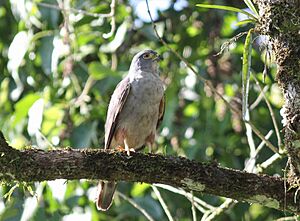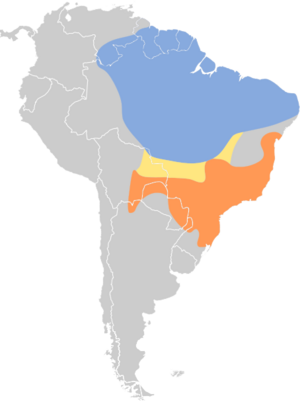Rufous-thighed kite facts for kids
Quick facts for kids Rufous-thighed kite |
|
|---|---|
 |
|
| Conservation status | |
| Scientific classification | |
| Genus: |
Harpagus
|
| Species: |
diodon
|
 |
|
| Nonbreeding Passage Breeding | |
The rufous-thighed kite (Harpagus diodon) is a type of bird of prey from the hawk family, Accipitridae. It lives regularly in countries like Argentina, Bolivia, Brazil, Guyana, Paraguay, and Suriname. Sometimes, it is also seen in Colombia, French Guiana, and Venezuela.
Contents
About This Bird
Even though it is called a "kite," the rufous-thighed kite is actually more closely related to the "true" hawks. It belongs to the same group as the double-toothed kite (H. bidentatus). This bird is unique because it is the only species in its specific group.
What Does It Look Like?
The rufous-thighed kite is about 29 to 35 centimeters (11 to 14 inches) long. Its wings can spread out to 60 to 70 centimeters (24 to 28 inches). Male and female kites look very similar, but the female is usually a little bigger.
Its name comes from its reddish-brown (chestnut) thighs. Adult birds have a dark gray head and back. Their tail is also dark gray with three lighter gray stripes and white tips on the feathers. The throat is whitish with a dark line down the middle. Their chest is gray, turning white under the tail. Their eyes are red or orange, and their beak's waxy part (called a cere) is bright yellow. Their legs are yellow to orange.
Younger birds have dark brown backs. They have streaks on the sides of their heads. Their undersides are whitish with some darker streaks on the chest and belly. They also have stripes on their sides.
Where Does It Live?
The rufous-thighed kite breeds in southern Brazil, northern Argentina, and Paraguay. When it is not breeding, it often moves north into the Amazon region of Brazil, Bolivia, Guyana, and Suriname. There have been reports of these birds visiting French Guiana and Venezuela. One sighting in Ecuador is still being checked.
This kite mostly lives in lowland rainforests. It prefers old, untouched forests. However, it can also be found in younger forests that have grown tall enough to form a closed roof of leaves. It has been seen in both thick and more open forests. Once, it was even spotted in a small forest area inside the city of São Paulo, Brazil.
How Does It Behave?
Migration Habits
The rufous-thighed kite is a bird that migrates from south to north. It moves from its breeding areas in the south up into the Amazon region. These birds have been seen migrating in loose groups of up to 30 individuals. Scientists are still learning more about their migration paths.
What Does It Eat?
The rufous-thighed kite hunts inside the forest. It usually stays in the middle or upper parts of the trees. It hunts by waiting on a branch and then grabbing its prey from other branches. It does not usually catch prey in mid-air.
Its diet mainly consists of insects like cicadas and grasshoppers. It also eats smaller numbers of lizards, birds, frogs, and small mammals. These kites have been seen following groups of army ants. They have also been seen following monkey troops to catch prey that the ants or monkeys stir up.
Reproduction and Life Cycle
The breeding season for the rufous-thighed kite is from October to February. This is during the late spring and summer in the southern parts of the world. They build a nest using small sticks. The nest is placed in a tree fork or on a horizontal branch.
They usually lay one or two eggs. The time it takes for the eggs to hatch is not known. The young birds leave the nest about four weeks after they hatch.
Vocalizations
When a young bird and a parent were on the nest, they made "high-pitched 'chee'" and "two-syllable 'chee-weet'" begging calls. This happened when the other parent came near with food. Adult kites also make a three-note sound.
Status and Conservation
The IUCN (International Union for Conservation of Nature) has listed the rufous-thighed kite as a species of "Least Concern." This means it is not currently in immediate danger of disappearing. It lives across a very large area. However, its total population size is not known, and it is thought to be decreasing. No direct threats have been found yet.
This bird breeds only in the Atlantic Forest, a large forest area that has been almost completely destroyed. Because of this, scientists now think that this species might need more conservation attention.
Images for kids




